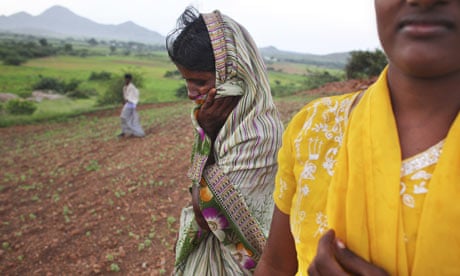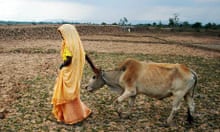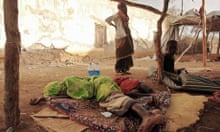In Andhra Pradesh, everyone we met had lost faith in the weather. "It is," said one woman, a groundnut farmer and a mother of five, "like a bad husband. You cannot understand his behaviour." Across the state and much of India the July monsoon had gone missing: it finally turned up 45 days late, and inadequate. "Scanty rain," we were told. "Maybe just five minutes one day. Raining on one field but not the next." No one had much idea why this had happened, and not many have heard the term "climate change". What they do know is that it is getting hotter, and that you can't rely on the rains any more.
By the end of September, when we arrived, a drought had been officially declared in Andhra Pradesh. Food prices were rising – rice up 20%, sugar 45%, most vegetables by even more. In Anantapur, the driest district of this dry state in the centre of the subcontinent, the farming families – some of the poorest people in India – were in crisis. Adults were going without meals to save money, children were being taken out of school, the older ones sent off to the city of Bangalore to look for work. The farmers were selling animals, registering for the government's rural employment scheme, doing anything they could to stave off the moneylenders. Then early this month, massive storms brought floods that drove nearly half a million people in Andhra Pradesh from their homes.
But no amount of rain could have helped Naryamaswamy Naik. "I don't know how much he had borrowed. I asked him, but he wouldn't say," said his wife, Sugali Nagamma. "I'd tell him: don't worry, we can sell the salt from our table. Everyone has debts." Her voice was low, her head bowed, as her tiny grandson played at her feet. She looked much older than her 41 years. Nagamma took the portrait of her husband from the wall to show him off, good-looking with an Elvis quiff when they met a quarter of a century ago. In July, Mr Naik took a tin of pesticide from the cupboard, opened it and drank it.
"He'd been unhappy for a month, but that day he was in a heavy depression. I tried to take the tin away from him but I couldn't. He died in front of us. The head of the family died in front of his wife and children – can you imagine?"
There has been an epidemic of suicides of farmers across India's drought-stricken regions these past few months. The stories behind them are all tragically similar. Debt is the driving force. In the Naiks's case, the poor returns from their rented 1.5 acres and the costs of schooling their five children had always meant finances were precarious. But it was the marriage of his oldest daughter that brought disaster to the family: the expense of the ceremony and her dowry putting his debts up to nearly 100,000 rupees (£1,300).
And then came the failure of the monsoon. Here in Andhra Pradesh, the farmers would expect to plant their staple crops of groundnut and sorghum in late June or early July, but no rain fell until 20 August. By then it was too late for groundnut, and the farmers of Kadiripalli village bought seeds of other crops, such as red gram and millet, to see if they would work. Though the smattering of rain has now turned the countryside green, the weak seedlings pushing through the red earth show that this effort won't come to much. It is another bad year.
In the villages of Anantapur people talk a lot about suicide. It's a sign, says Oxfam's regional manager, Shaik Anwar, that all other coping mechanisms have failed. "They already have a huge amount of debt, and the delay of four or five weeks in the planting season just finishes people. A shortfall in rain is OK, people are used to drought, but this is different: farmers lost the seed and they lost the crop. Often the social pressures contribute to suicides: marrying a daughter is very tough. The culture is that they have to feed 50 or 100 families at the ceremony, even when they don't have enough grain at home for themselves."
In Sugali Nagamma's hut, under the portrait of her dead husband, we saw a pile of full sacks of jawa – sorghum seed that she'd bought with the help of Hands, a local NGO supported by Oxfam India. It was a last attempt to get a food crop this season, but in the parched ground the sorghum could not germinate. With the wells dry, there was no way to water it. So Nagamma and her three younger children are all working as labourers – the children have dropped out of school. They get 30 rupees (about 40 pence) a day from farmers, or 100 rupees if they can get on to a government scheme designed to help the rural poor. There's also government-subsidised rice, though Nagamma says it only lasts one week in the month.
But Nagamma's main concern is not that she will feed herself – and she looks very thin – but that now her husband is gone, the debts will never be paid and she will not manage to marry her other three daughters. "When I think about these things I feel black," she says. "It's only the thought of my children being alone that stops me killing myself."
Does she blame the weather? "This year is the very worst year since I was a child. This year the main crop, the groundnut, has failed. In the past we could go elsewhere to labour but not now, because the drought is everywhere. The clouds are not coming into our area to give us rain."
So – is this climate change? Few people we met knew the meaning of the term – they thought we were talking about the need to protect and regrow the forests, something that the NGOs in the area educate the farmers about. But everyone had stories to tell of changes in the weather, of the unreliable seasons, of rain that came too late, or too strong, washing away carefully planted fields in a single downpour. The extreme heat of summer is another common complaint. Peter Balaram, project director of Apps, a network of environmental NGOs training and organising the farmers of Anantapur, says that summer temperatures can be 10°C hotter now than in the past. Since they can reach 45°C, this makes work outdoors near impossible.
Ramesh Naik, a 35-year-old red gram farmer, told us that he had sold his last goats to buy rice for his family – they were existing now on that and mashed herbs. "When I was a child everywhere there was water, and rains. I suppose those were the golden days – now we're always looking to the sky, looking for the rain. It was eight or 10 years ago that things started changing. Every year since has become worse, and food problems have got worse. Before, if something was required people would share; now there's no support, no sharing of grain or anything. People can't afford to help any more. Everyone is in crisis."


